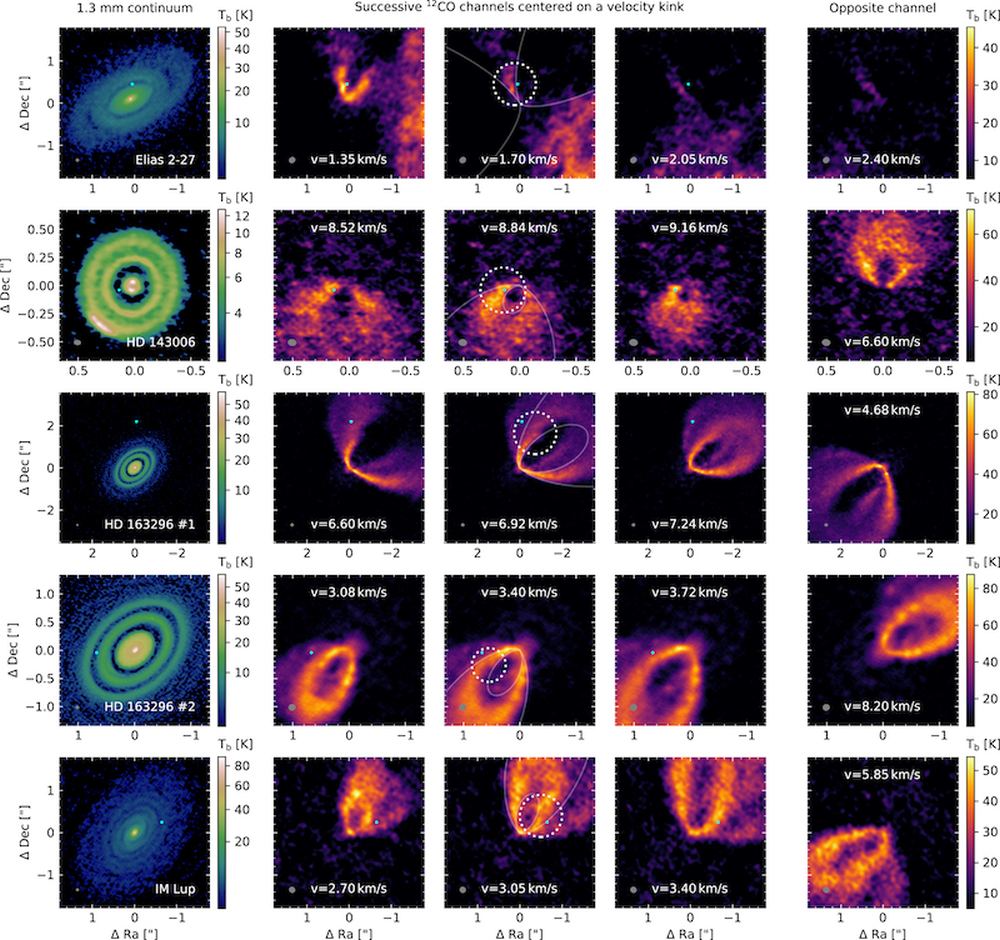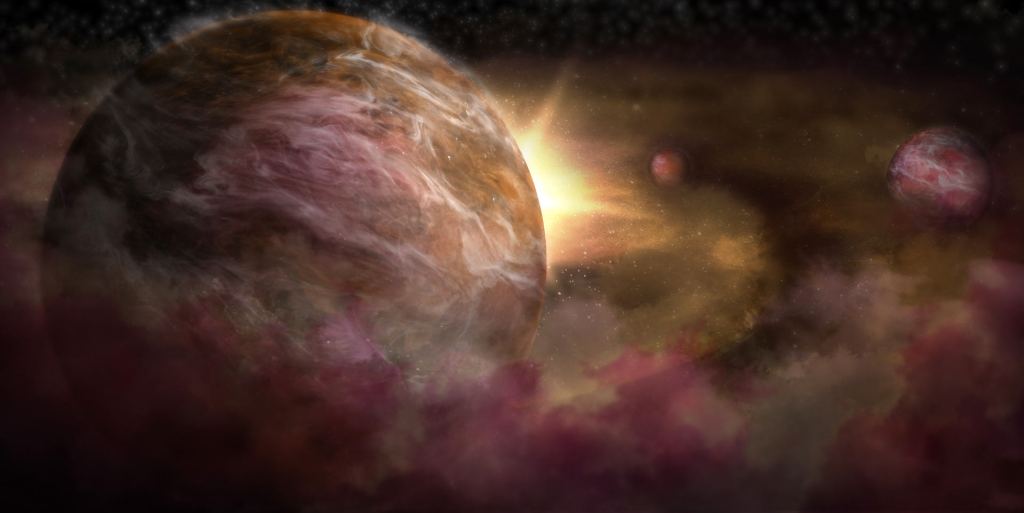Astronomers like observing distant young stars as they form. Stars are born out of a molecular cloud, and once enough of the matter in that cloud clumps together, fusion ignites and a star begins its life. The leftover material from the formation of the star is called a circumstellar disk.
As the material in the circumstellar disk swirls around the now-rotating star, it clumps up into individual planets. As planets form in it, they leave gaps in that disk. Or so we think.
One of the most observed young stars is called HL Tauri. It’s in the constellation Taurus and is about 450 light years away. The Atacama Large Millimeter Array (ALMA) captured a well-known image of HL Tauri in 2014. That image is the sharpest image ever taken by ALMA.

Since then, astronomers have observed other young stars, and also found gaps in their disks. Note that ALMA, as its name tells us, is not a visible light telescope. There’s so much gas and dust in circumstellar disks that visible light is useless for studying them. ALMA observes in wavelengths of light between infrared and radio waves, so it can see into the swirling disk of gas and dust.
A new study looked at 18 young stars and their disks, and found evidence that 8 of those stars have what they call “velocity kinks” that may signal the presence of young, still-forming planets. The study is titled “Nine Localized Deviations from Keplerian Rotation in the DSHARP Circumstellar Disks: Kinematic Evidence for Protoplanets Carving the Gaps.” Lead author of the study is Christophe Pinte of Monash University, Australia, and the University of Grenoble Alpes, France). The paper is published in The Astrophysical Journal Letters.
Though astronomers can see the gaps in circumstellar disks, they can’t see the planets. After years of trying with some of the world’s best telescopes, astronomers have only directly imaged a single exoplanet in a gap around one star. So even though it might seem obvious that baby planets are responsible, and there’s really no other way they could form, it’s still an unproven theory. This new study helps make the case that at least some of the observed gaps in circumstellar disks are caused by planets.
This study used data from the Disk Substructures at High Angular Resolution (DSHARP) project. DSHARP uses ALMA to study nearby bright circumstellar disks (also called protoplanetary disks). According to the website, DSHARP is “designed to assess the prevalence, forms, locations, sizes, and amplitudes of small-scale substructures in the distributions of the disk material and how they might be related to the planet formation process.”

There are other candidate explanations for the gaps in the disks. One is snow lines, or frost lines. In a circumstellar debris disk, a frost line is the distance from the star where it’s cold enough for volatiles to freeze. This includes not only water ice, but also ammonia, methane, carbon dioxide and others. Beyond the frost line, these substances freeze into solid ice grains.
Another possible explanation for these gaps is dust grain sintering. That’s when dust compacts into a solid structure through heat and pressure, but without melting. A team of scientists explored that idea in this paper.
Other candidates include magneto-hydrodynamic effects, zonal flows, and self-induced dust traps. After the 2014 ALMA image of HL Tauri and its rings, researchers published a number of papers presenting evidence in favour of all of these possible explanations.

But none of them are as intriguing as the baby planet explanation. And since we now know that most, if not all , stars host exoplanets, it makes sense.
ALMA doesn’t just take pictures of these young stars and their debris disks. It uses its power to study the gas distribution in the disks. The image below is from the new study. It compares gas distribution in five disks with velocity measurements of the same disk.

At the heart of this new study are what’s called “velocity kinks.”
The circumstellar debris disk around HL Tauri and other young stars is largely made of gas, and it’s rotating. As it rotates, its movement is governed by Keplerian velocity. Keplerian velocity describes how a disk of material should move when it’s dominated by a massive body at its centre. But as the image above shows, there are kinks in the gas. According to the authors of the new paper, these kinks are evidence of young planets.
From the paper: “Embedded planets perturb the Keplerian gas flow in their vicinity, launching spiral waves at Lindblad resonances both inside and outside their orbits.”
For at least one of the 20 young stars, the disrupted flow is evidence of large gas giants: “Accurate measurements of rotation curves revealed, for instance, radial pressure gradients and vertical flows, likely driven by gaps carved in the gas surface density by Jupiter-mass planets in the disk of HD 163296.”

The study presents a lot of strong evidence in support of protoplanets. But the authors acknowledge that there could be other causes. One of them is in the data itself.
“Several observational effects and physical mechanisms may produce features in the channel maps that look like velocity kinks,” the authors say. “The most obvious one is the reconstruction process at low signal-to-noise ratio that often results in patchy emission that could be mistaken for kinks. We cannot exclude that such artifacts are present in the DSHARP data…”
But they’ve taken steps to eliminate those errors, and in the end of their paper they make several statements in summary:
- “We found nine localized (channel-specific) velocity perturbations indicative of non-Keplerian motion in DSHARP observations of 8 protoplanetary disks, out of the 18 selected sources.”
- “The presence of embedded planets would naturally explain both the continuum rings and gas velocity deviations from Keplerian rotation.”
- “If planets are indeed responsible for these tentative velocity kinks, they should have masses of the order of a Jupiter mass.”
- In several cases, the authors couldn’t reach definitve conclusions. “… nondetections in other disks or in other gaps in disks where we detected a kink do not necessarily imply the absence of Jupiter-mass planets.”
So there we have it. This thorough and interesting paper advances the idea that gaps in circumstellar debris disks are indeed caused by baby planets.
As our observing power grows, and as telescopes like the James Webb and others become operational, the evidence will likely grow more conclusive.
But in science, you don’t know until you know.
More:
- Press Release: Featured Image: Evidence for Planets in Disks?
- Research Paper: Nine Localized Deviations from Keplerian Rotation in the DSHARP Circumstellar Disks: Kinematic Evidence for Protoplanets Carving the Gaps
- Universe Today: Look at This Fascinating Variety of Planet-Forming Disks Around Other Stars

Thanks, a really nice synthesis! There are several processes that can spawn planets. Earth seem from isotope data possibly somewhat core accreted but having its bulk from pebble rain [ https://www.livescience.com/meteorite-iron-shows-earth-formed-fast.html ]. So it seems likelier that we see planets than any one of putative planet building processes (such as dust traps).
I also discovered that Bertil Lindblad hailed from my alma mater.